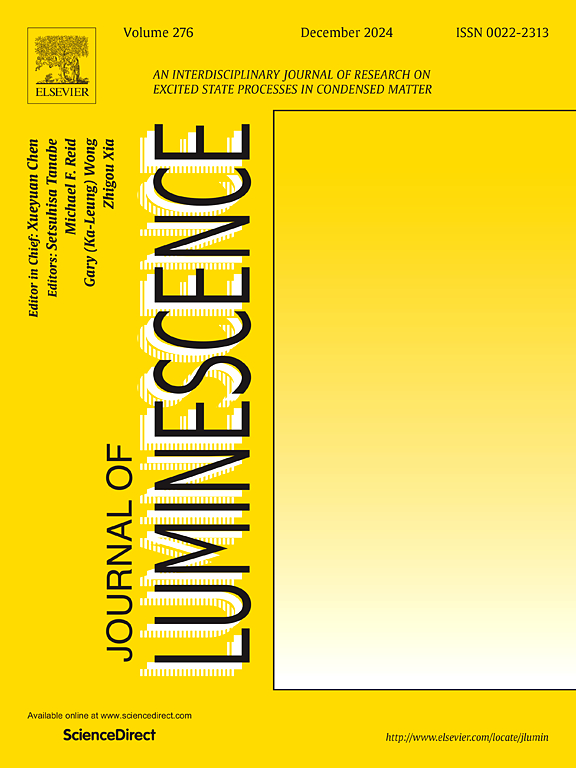Cr3+激活Gd2Ga1-2xZnxSixSbO7荧光粉的增强宽带近红外发光功能
IF 3.3
3区 物理与天体物理
Q2 OPTICS
引用次数: 0
摘要
近红外(NIR)光谱学的快速发展刺激了对新型宽带近红外荧光粉的巨大需求。本文设计了[Zn2+-Si4+]→[Ga3+-Ga3+]共取代策略,以改变Gd2GaSbO7中Cr3+的局部对称性和晶体场环境。因此,在460 nm光的照射下,发光经历了显著的增强、展宽和红移。Gd2Ga0.91Zn0.02Si0.02SbO7:5%Cr3+荧光粉显示出以797nm为中心的宽带发射,最大半宽为126nm。在423 K时,近红外发射强度保持了环境值的50.96%。最终,该荧光粉被成功封装到蓝芯片中,制成近红外荧光粉转换发光二极管(pc-LED),其近红外输出功率为47.83 mW,光电效率为10.70%。这些结果强调了Gd2Ga1-2xZnxSixSbO7:Cr3+作为先进近红外光谱应用的高性能材料的潜力。本文章由计算机程序翻译,如有差异,请以英文原文为准。
Enhanced broadband near-infrared luminescence in Cr3+-activated Gd2Ga1-2xZnxSixSbO7 phosphors for multifunctional applications
The rapid advancement of near-infrared (NIR) spectroscopy has spurred a significant demand for innovative broadband NIR phosphors. Here, a [Zn2+-Si4+] → [Ga3+-Ga3+] co-substitution strategy is designed to modify the local symmetry and crystal field environment of Cr3+ in Gd2GaSbO7. Consequently, the luminescence experiences notable enhancement, broadening, and red-shifting under an irradiation of 460 nm light. The Gd2Ga0.91Zn0.02Si0.02SbO7:5%Cr3+ phosphor demonstrates a broadband emission centered at 797 nm with a full-width at half maximum of 126 nm. Moreover, the NIR emission intensity retains 50.96% of the ambient value at 423 K. Ultimately, the as-obtained phosphor was successfully encapsulated into a blue chip to manufacture a NIR phosphor-converted light-emitting diode (pc-LED) with an NIR output power of 47.83 mW and a photoelectric efficiency of 10.70%. These results underscore the potential of Gd2Ga1-2xZnxSixSbO7:Cr3+ as a high-performance material for advanced NIR spectroscopy applications.
求助全文
通过发布文献求助,成功后即可免费获取论文全文。
去求助
来源期刊

Journal of Luminescence
物理-光学
CiteScore
6.70
自引率
13.90%
发文量
850
审稿时长
3.8 months
期刊介绍:
The purpose of the Journal of Luminescence is to provide a means of communication between scientists in different disciplines who share a common interest in the electronic excited states of molecular, ionic and covalent systems, whether crystalline, amorphous, or liquid.
We invite original papers and reviews on such subjects as: exciton and polariton dynamics, dynamics of localized excited states, energy and charge transport in ordered and disordered systems, radiative and non-radiative recombination, relaxation processes, vibronic interactions in electronic excited states, photochemistry in condensed systems, excited state resonance, double resonance, spin dynamics, selective excitation spectroscopy, hole burning, coherent processes in excited states, (e.g. coherent optical transients, photon echoes, transient gratings), multiphoton processes, optical bistability, photochromism, and new techniques for the study of excited states. This list is not intended to be exhaustive. Papers in the traditional areas of optical spectroscopy (absorption, MCD, luminescence, Raman scattering) are welcome. Papers on applications (phosphors, scintillators, electro- and cathodo-luminescence, radiography, bioimaging, solar energy, energy conversion, etc.) are also welcome if they present results of scientific, rather than only technological interest. However, papers containing purely theoretical results, not related to phenomena in the excited states, as well as papers using luminescence spectroscopy to perform routine analytical chemistry or biochemistry procedures, are outside the scope of the journal. Some exceptions will be possible at the discretion of the editors.
 求助内容:
求助内容: 应助结果提醒方式:
应助结果提醒方式:


